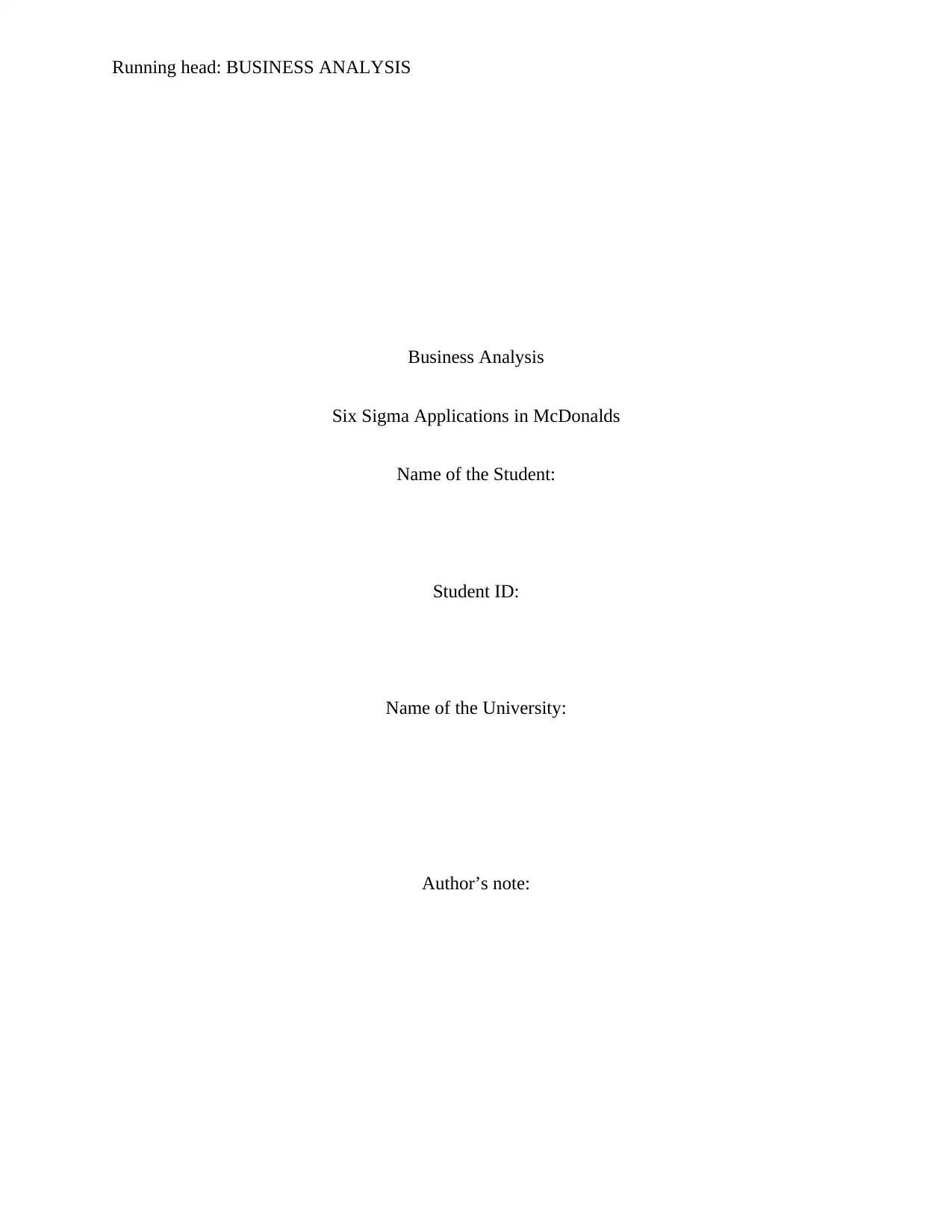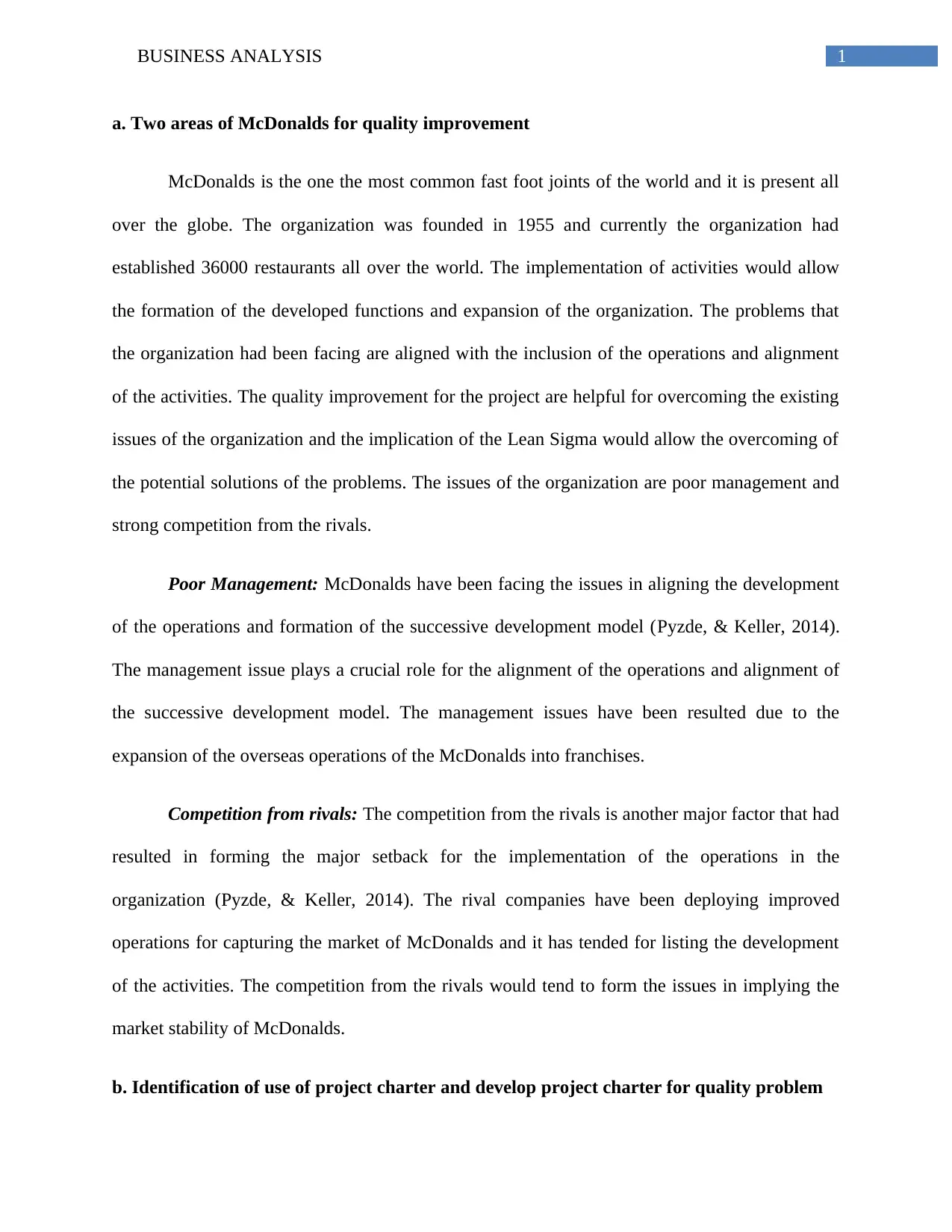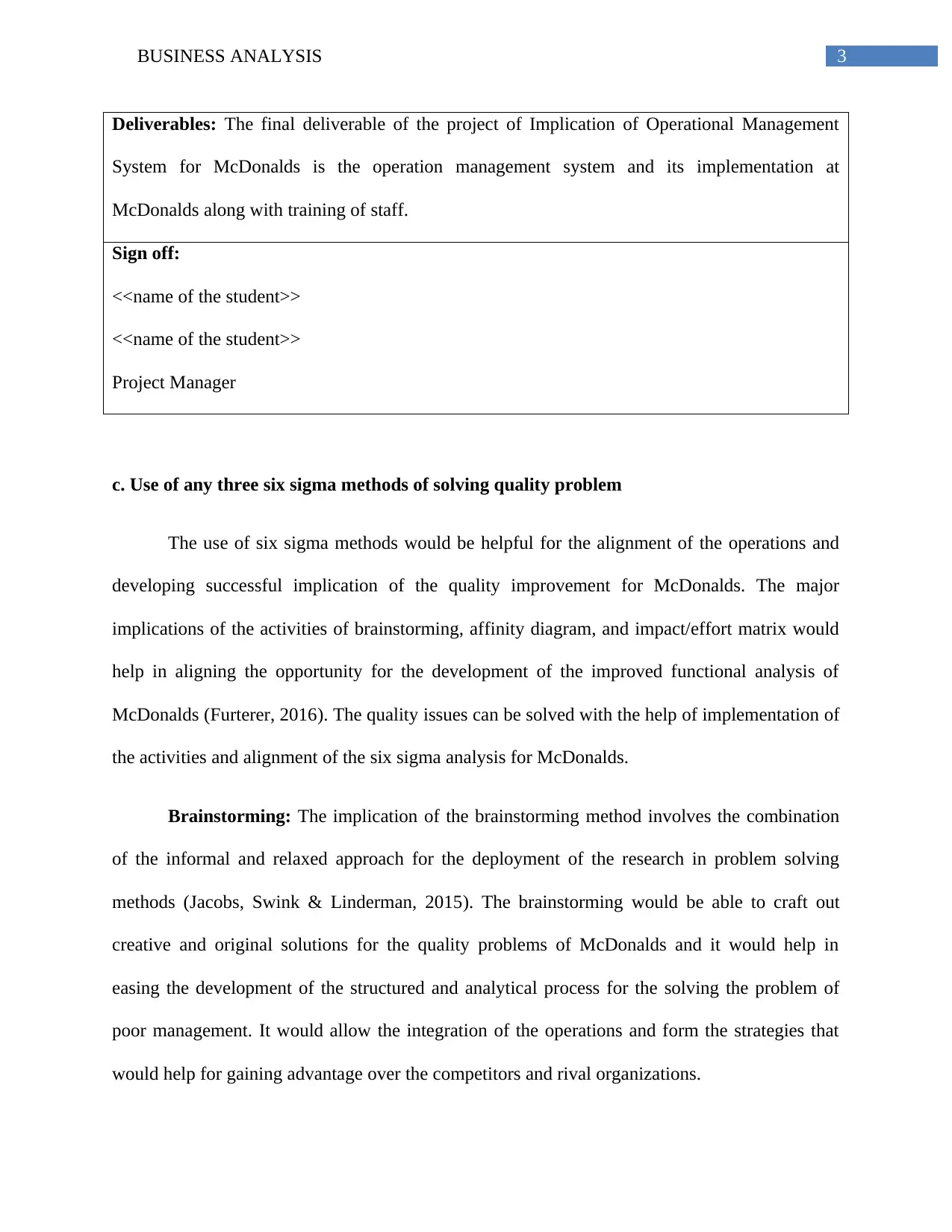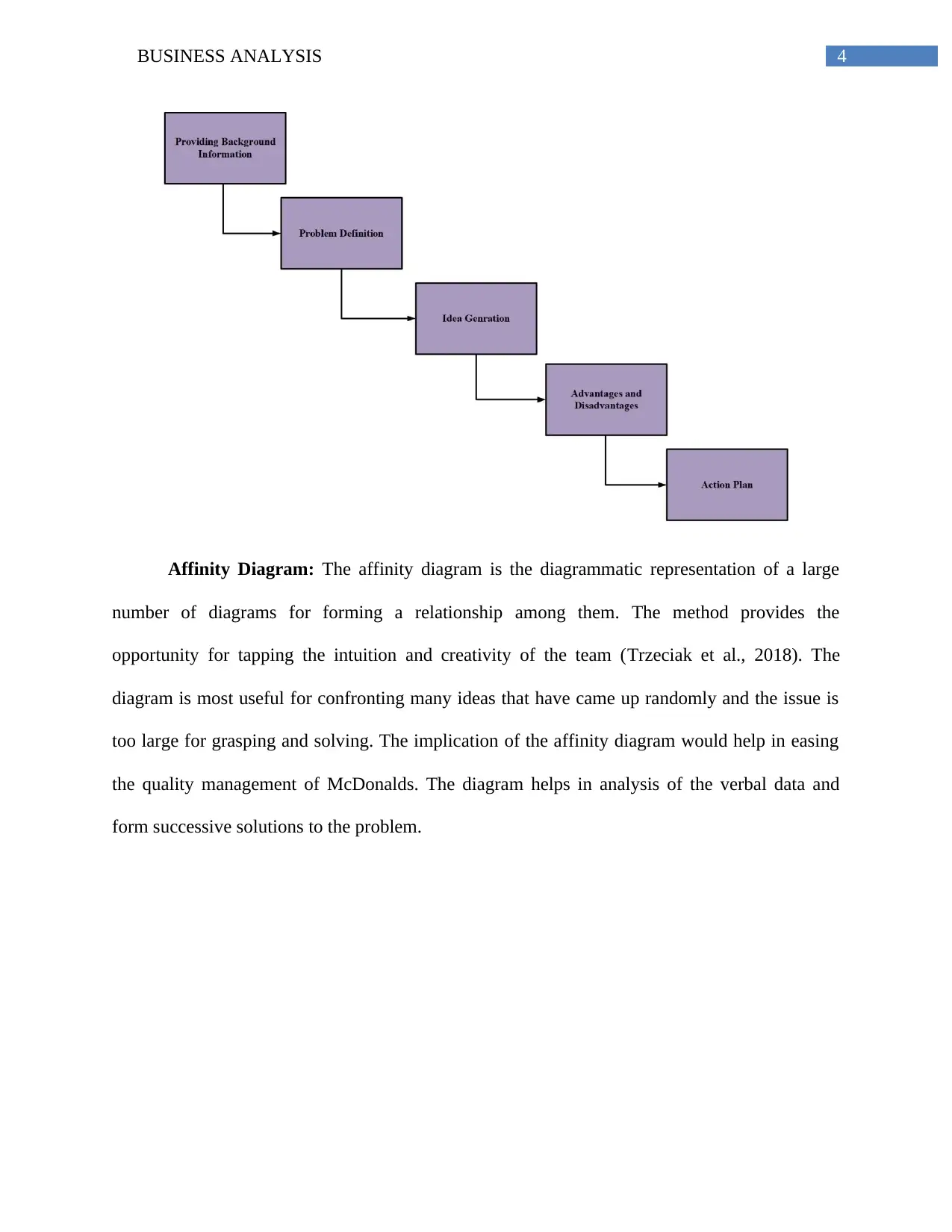Applying Lean Six Sigma to Improve McDonald's Quality Performance
VerifiedAdded on 2023/06/13
|7
|1387
|383
Report
AI Summary
This report explores the application of Lean Six Sigma methodologies to enhance quality performance within McDonald's operations. It identifies poor management and competition from rivals as key areas for improvement. A project charter is developed for implementing an operational management system to address poor management. The report further proposes and examines the use of three Six Sigma techniques—brainstorming, affinity diagrams, and impact/effort matrix—to generate, prioritize, and evaluate potential solutions to quality problems. Brainstorming facilitates creative solutions, affinity diagrams organize ideas, and the impact/effort matrix evaluates the feasibility and impact of proposed solutions. The ultimate goal is to improve operational efficiency and gain a competitive advantage for McDonald's. Desklib provides similar solved assignments for students.

Running head: BUSINESS ANALYSIS
Business Analysis
Six Sigma Applications in McDonalds
Name of the Student:
Student ID:
Name of the University:
Author’s note:
Business Analysis
Six Sigma Applications in McDonalds
Name of the Student:
Student ID:
Name of the University:
Author’s note:
Paraphrase This Document
Need a fresh take? Get an instant paraphrase of this document with our AI Paraphraser

1BUSINESS ANALYSIS
a. Two areas of McDonalds for quality improvement
McDonalds is the one the most common fast foot joints of the world and it is present all
over the globe. The organization was founded in 1955 and currently the organization had
established 36000 restaurants all over the world. The implementation of activities would allow
the formation of the developed functions and expansion of the organization. The problems that
the organization had been facing are aligned with the inclusion of the operations and alignment
of the activities. The quality improvement for the project are helpful for overcoming the existing
issues of the organization and the implication of the Lean Sigma would allow the overcoming of
the potential solutions of the problems. The issues of the organization are poor management and
strong competition from the rivals.
Poor Management: McDonalds have been facing the issues in aligning the development
of the operations and formation of the successive development model (Pyzde, & Keller, 2014).
The management issue plays a crucial role for the alignment of the operations and alignment of
the successive development model. The management issues have been resulted due to the
expansion of the overseas operations of the McDonalds into franchises.
Competition from rivals: The competition from the rivals is another major factor that had
resulted in forming the major setback for the implementation of the operations in the
organization (Pyzde, & Keller, 2014). The rival companies have been deploying improved
operations for capturing the market of McDonalds and it has tended for listing the development
of the activities. The competition from the rivals would tend to form the issues in implying the
market stability of McDonalds.
b. Identification of use of project charter and develop project charter for quality problem
a. Two areas of McDonalds for quality improvement
McDonalds is the one the most common fast foot joints of the world and it is present all
over the globe. The organization was founded in 1955 and currently the organization had
established 36000 restaurants all over the world. The implementation of activities would allow
the formation of the developed functions and expansion of the organization. The problems that
the organization had been facing are aligned with the inclusion of the operations and alignment
of the activities. The quality improvement for the project are helpful for overcoming the existing
issues of the organization and the implication of the Lean Sigma would allow the overcoming of
the potential solutions of the problems. The issues of the organization are poor management and
strong competition from the rivals.
Poor Management: McDonalds have been facing the issues in aligning the development
of the operations and formation of the successive development model (Pyzde, & Keller, 2014).
The management issue plays a crucial role for the alignment of the operations and alignment of
the successive development model. The management issues have been resulted due to the
expansion of the overseas operations of the McDonalds into franchises.
Competition from rivals: The competition from the rivals is another major factor that had
resulted in forming the major setback for the implementation of the operations in the
organization (Pyzde, & Keller, 2014). The rival companies have been deploying improved
operations for capturing the market of McDonalds and it has tended for listing the development
of the activities. The competition from the rivals would tend to form the issues in implying the
market stability of McDonalds.
b. Identification of use of project charter and develop project charter for quality problem

2BUSINESS ANALYSIS
The poor management system can be improved by the help of the implication of an
operation management system. The implication of the operation management system would be
based on the IT project planning and scheduling methods However, the use of project charter
would help in providing the initial documentation requirement for the project. The charter would
provide overview of the activities aligned for the development of the activities. The following is
a project charter document for the project of Implication of Operational Management System for
McDonalds for overcoming the problem of poor management.
Project Charter
Project Name: Implication of Operational Management System for McDonalds
Documented by: Ashley Jones
Version: 1.0 Date: 08/04/18
Project Statement: The project is formed for implication of an operational management system
and the alignment of the activities for listing the management operations favourable for the
development of smart operations.
Project Goal: The project would consider the use of technology improvement for developing the
effective operational management system for McDonalds. The implementation of the operational
management system would help in easing the operations and overcome the issues of poor
management of the activities.
Project Objectives: To implement the system for overcoming the issues of the poor
management and the competition from the rivals.
Project Scope: The project involves the plan schedule, design development, operation
alignment, and system implementation as the scope items for the project of Implication of
Operational Management System for McDonalds
The poor management system can be improved by the help of the implication of an
operation management system. The implication of the operation management system would be
based on the IT project planning and scheduling methods However, the use of project charter
would help in providing the initial documentation requirement for the project. The charter would
provide overview of the activities aligned for the development of the activities. The following is
a project charter document for the project of Implication of Operational Management System for
McDonalds for overcoming the problem of poor management.
Project Charter
Project Name: Implication of Operational Management System for McDonalds
Documented by: Ashley Jones
Version: 1.0 Date: 08/04/18
Project Statement: The project is formed for implication of an operational management system
and the alignment of the activities for listing the management operations favourable for the
development of smart operations.
Project Goal: The project would consider the use of technology improvement for developing the
effective operational management system for McDonalds. The implementation of the operational
management system would help in easing the operations and overcome the issues of poor
management of the activities.
Project Objectives: To implement the system for overcoming the issues of the poor
management and the competition from the rivals.
Project Scope: The project involves the plan schedule, design development, operation
alignment, and system implementation as the scope items for the project of Implication of
Operational Management System for McDonalds
⊘ This is a preview!⊘
Do you want full access?
Subscribe today to unlock all pages.

Trusted by 1+ million students worldwide

3BUSINESS ANALYSIS
Deliverables: The final deliverable of the project of Implication of Operational Management
System for McDonalds is the operation management system and its implementation at
McDonalds along with training of staff.
Sign off:
<<name of the student>>
<<name of the student>>
Project Manager
c. Use of any three six sigma methods of solving quality problem
The use of six sigma methods would be helpful for the alignment of the operations and
developing successful implication of the quality improvement for McDonalds. The major
implications of the activities of brainstorming, affinity diagram, and impact/effort matrix would
help in aligning the opportunity for the development of the improved functional analysis of
McDonalds (Furterer, 2016). The quality issues can be solved with the help of implementation of
the activities and alignment of the six sigma analysis for McDonalds.
Brainstorming: The implication of the brainstorming method involves the combination
of the informal and relaxed approach for the deployment of the research in problem solving
methods (Jacobs, Swink & Linderman, 2015). The brainstorming would be able to craft out
creative and original solutions for the quality problems of McDonalds and it would help in
easing the development of the structured and analytical process for the solving the problem of
poor management. It would allow the integration of the operations and form the strategies that
would help for gaining advantage over the competitors and rival organizations.
Deliverables: The final deliverable of the project of Implication of Operational Management
System for McDonalds is the operation management system and its implementation at
McDonalds along with training of staff.
Sign off:
<<name of the student>>
<<name of the student>>
Project Manager
c. Use of any three six sigma methods of solving quality problem
The use of six sigma methods would be helpful for the alignment of the operations and
developing successful implication of the quality improvement for McDonalds. The major
implications of the activities of brainstorming, affinity diagram, and impact/effort matrix would
help in aligning the opportunity for the development of the improved functional analysis of
McDonalds (Furterer, 2016). The quality issues can be solved with the help of implementation of
the activities and alignment of the six sigma analysis for McDonalds.
Brainstorming: The implication of the brainstorming method involves the combination
of the informal and relaxed approach for the deployment of the research in problem solving
methods (Jacobs, Swink & Linderman, 2015). The brainstorming would be able to craft out
creative and original solutions for the quality problems of McDonalds and it would help in
easing the development of the structured and analytical process for the solving the problem of
poor management. It would allow the integration of the operations and form the strategies that
would help for gaining advantage over the competitors and rival organizations.
Paraphrase This Document
Need a fresh take? Get an instant paraphrase of this document with our AI Paraphraser

4BUSINESS ANALYSIS
Affinity Diagram: The affinity diagram is the diagrammatic representation of a large
number of diagrams for forming a relationship among them. The method provides the
opportunity for tapping the intuition and creativity of the team (Trzeciak et al., 2018). The
diagram is most useful for confronting many ideas that have came up randomly and the issue is
too large for grasping and solving. The implication of the affinity diagram would help in easing
the quality management of McDonalds. The diagram helps in analysis of the verbal data and
form successive solutions to the problem.
Affinity Diagram: The affinity diagram is the diagrammatic representation of a large
number of diagrams for forming a relationship among them. The method provides the
opportunity for tapping the intuition and creativity of the team (Trzeciak et al., 2018). The
diagram is most useful for confronting many ideas that have came up randomly and the issue is
too large for grasping and solving. The implication of the affinity diagram would help in easing
the quality management of McDonalds. The diagram helps in analysis of the verbal data and
form successive solutions to the problem.

5BUSINESS ANALYSIS
Impact/Effort Matrix: The impact/effort matrix is a graphical representation of the
effort required for the solution and impact of the solution (Marnika, Christodoulou & Xenidis,
2015). The two axes of the graph are Impact of the solution (Y axis) and Effort required to
implement (X axis). The four quadrants would help in listing the activities that are required for
solving the positioning of the operations. The use of the impact/effort matrix would evaluate the
solutions for the quality improvement of the McDonalds and it would help in easing the final
development of the activities.
Impact/Effort Matrix: The impact/effort matrix is a graphical representation of the
effort required for the solution and impact of the solution (Marnika, Christodoulou & Xenidis,
2015). The two axes of the graph are Impact of the solution (Y axis) and Effort required to
implement (X axis). The four quadrants would help in listing the activities that are required for
solving the positioning of the operations. The use of the impact/effort matrix would evaluate the
solutions for the quality improvement of the McDonalds and it would help in easing the final
development of the activities.
⊘ This is a preview!⊘
Do you want full access?
Subscribe today to unlock all pages.

Trusted by 1+ million students worldwide

6BUSINESS ANALYSIS
References
Furterer, S. (2016). Project Charter Review Process Design—A Design for Six Sigma Case
Study. In Design for Six Sigma in Product and Service Development (pp. 354-405). CRC
Press.
Furterer, S. L. (Ed.). (2016). Lean Six Sigma in service: applications and case studies. CRC
Press.
Jacobs, B. W., Swink, M., & Linderman, K. (2015). Performance effects of early and late Six
Sigma adoptions. Journal of Operations Management, 36, 244-257.
Marnika, E., Christodoulou, E., & Xenidis, A. (2015). Sustainable development indicators for
mining sites in protected areas: tool development, ranking and scoring of potential
environmental impacts and assessment of management scenarios. Journal of Cleaner
Production, 101, 59-70.
Pyzdek, T., & Keller, P. A. (2014). The six sigma handbook (Vol. 4). New York: McGraw-Hill
Education.
Serenari, C., Peterson, M. N., Wallace, T., & Stowhas, P. (2017). Private protected areas,
ecotourism development and impacts on local people's well-being: a review from case
studies in Southern Chile. Journal of Sustainable Tourism, 25(12), 1792-1810.
Trzeciak, S., Mercincavage, M., Angelini, C., Cogliano, W., Damuth, E., Roberts, B. W., ... &
Mazzarelli, A. J. (2018). Lean Six Sigma to Reduce Intensive Care Unit Length of Stay
and Costs in Prolonged Mechanical Ventilation. Journal for Healthcare Quality, 40(1),
36-43.
References
Furterer, S. (2016). Project Charter Review Process Design—A Design for Six Sigma Case
Study. In Design for Six Sigma in Product and Service Development (pp. 354-405). CRC
Press.
Furterer, S. L. (Ed.). (2016). Lean Six Sigma in service: applications and case studies. CRC
Press.
Jacobs, B. W., Swink, M., & Linderman, K. (2015). Performance effects of early and late Six
Sigma adoptions. Journal of Operations Management, 36, 244-257.
Marnika, E., Christodoulou, E., & Xenidis, A. (2015). Sustainable development indicators for
mining sites in protected areas: tool development, ranking and scoring of potential
environmental impacts and assessment of management scenarios. Journal of Cleaner
Production, 101, 59-70.
Pyzdek, T., & Keller, P. A. (2014). The six sigma handbook (Vol. 4). New York: McGraw-Hill
Education.
Serenari, C., Peterson, M. N., Wallace, T., & Stowhas, P. (2017). Private protected areas,
ecotourism development and impacts on local people's well-being: a review from case
studies in Southern Chile. Journal of Sustainable Tourism, 25(12), 1792-1810.
Trzeciak, S., Mercincavage, M., Angelini, C., Cogliano, W., Damuth, E., Roberts, B. W., ... &
Mazzarelli, A. J. (2018). Lean Six Sigma to Reduce Intensive Care Unit Length of Stay
and Costs in Prolonged Mechanical Ventilation. Journal for Healthcare Quality, 40(1),
36-43.
1 out of 7